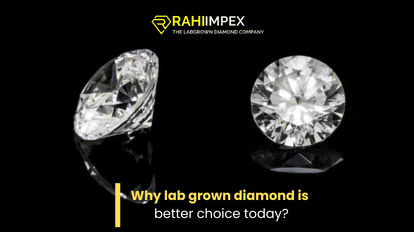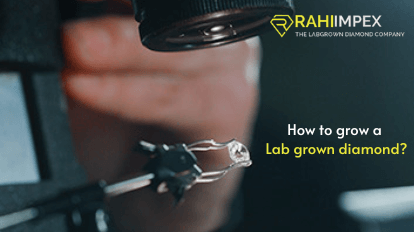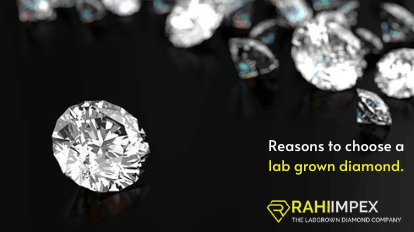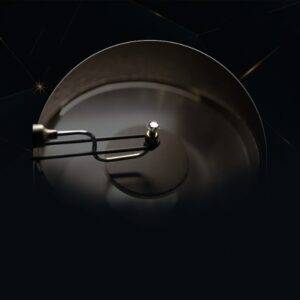Home »
Introduction
Synthetic diamonds are considered to be one of the most useful results of technological advancements that have happened in the past few decades. Unlike other inventions, lab grown diamonds manufacturer do not have disadvantages that make them less preferable than mined diamonds. In fact, these gemstones are becoming popular by the day.
In terms of physical properties and looks, synthetic diamonds are not different from natural rough stones. Yet, there are considerable differences between the two. Knowing these differences can help to analyze a diamond better.
Mode of origin
Natural diamonds are the result of environmental changes and circumstances that decide the nature and texture of the rough stone formed. Immense heat and pressure that arise as the consequence of different natural phenomena lead to the formation of these incredible stones that vary in size, texture, and color.
Diamonds are found deep under the Earth’s crust. The depth can go up to 150-200 km below the surface. Due to the high pressure here, the carbon particles present in the soil get crystallized forming the stones that we call as diamonds. Going below the surface to reach these diamonds is nearly impossible. Nature does play a part in bringing these stones near to the surface as well. The formation of molten magma under the crust, at temperatures of 900 to 1,300 degrees Celsius along with 45 to 60 kilobytes pressure becomes a path for the diamonds to reach the upper layers. When the magma erupts and expands, the rocks bearing the diamonds also move upward with it, making it easy for the humans to reach them.
These diamond bearing rocks are then dug out through mining, which involves physical labor and machines. The process is difficult and carries risk elements for those who become a part of it. Extraction of diamonds is done in different ways, such as pipe mining, alluvial mining and marine mining.
Lab grown diamonds manufacturer and wholesaler, on the other hand, are completely formed in a side a laboratory. From the beginning till the very end, synthetic diamonds are the products of a manually created atmosphere where diamond seeds taken from natural diamonds are developed in diamond-making machines. The lab grown diamonds are primarily of two types: HPHT diamonds and CVD diamonds.
The HPHT or High Pressure, High Temperature method is where high pressure and high temperature is applied to graphite. The intense atmosphere makes the graphite dissolve into carbon atoms and these particles with the help of a liquid nickel or cobalt get coated around the diamond seed. The whole process happens inside a small capsule. CVD diamonds are the result of the method called Chemical Vapor Deposition. Here, the diamond seed is placed inside a chamber filled with hydrocarbon gas. At low temperature and high pressure, the carbon particles from the gas start to attach themselves to the seed, with time making it grow in size. The CVD method is more cost-friendly compared to the HPHT method.
Time taken for the formation
Natural diamonds are the result of years of changes that happen in nature. A diamond takes approximately 1 to 3 billion years to form. This is due to the requirement of the right conditions and the slow mode in which these conditions develop.
Lab grown diamonds take a period of 3 to 4 months for the formation. As the atmosphere is artificially created, the process of formation is smoother and faster compared to natural diamonds. Unlike natural diamonds, the path of formation is not affected by any other phenomenon. Once placed inside the machine, the diamond seed stays at the same place it reaches its matured state. Once the diamond reaches its final form it is taken out, analyzed, and polished.
Environmental Impact
Rarity and difficulty to extract make natural diamonds valuable. Yet, the same reasons are also why these gemstones are losing their place to synthetic diamonds. The procedures that are involved in extracting natural diamonds are harmful not just to the Earth, but also to other living beings including humans. Mining leaves huge holes that affect the ecosystem. This leads to further problems such as soil erosion, deforestation, landslides, earthquakes, etc.
Indigenous communities across the world are often under threat as mining takes up land. They are helpless even when their livelihoods are affected severely due to these activities. Often they lose their homes in the process. Moreover, manual labour involved is at risk of serious injuries or even death. Workers are exploited and are made to work without adequate safety measures. Child labour, another major problem is now strictly banned in many countries.
With synthetic diamonds, none of the above mentioned concerns arise. They are made completely in safe environments closed inside the four walls. Machines are involved in the making of these diamonds that the demand for manual labour is almost null.
Chemical Properties
In terms of chemical deposition, both natural and synthetic diamonds are the same. As the core element is carbon, the diamonds formed by developing it tend to have the same chemical and optical properties whether formed naturally or otherwise. Due to this reason, telling them apart from each other is not easy. Diamond experts use methods and machines for identification.
Presence of Inclusions
Metal fluxes are used by synthetic diamonds for formation. These fluxes leave marks on the surface of the diamonds grown artificially. Synthetic diamonds, therefore, have metallic inclusions on their texture. They play a significant part in deciding the quality of the diamond. Varying in size, some inclusions are microscopic while others can be observed with naked eyes. Moreover, these tend to be magnetic in nature and get attracted to strong magnets if placed nearby.
Natural diamonds do not have inclusions in them. Due to the natural way in which they are formed, magnetic inclusions are not a part of them. Genealogists use inclusions as a way of identifying synthetic diamonds.
Spectral features
The two types of diamond also differ in the way they project their spectral features. Whether colored or natural, the way a gem reflects light can also reveal the kind of diamond it is. The most common spectral features, observed are lines that are measured in nanometer (nm)
Natural diamonds tend to have “Cape lines”. It is observed that these lines at 415nm in a colorless or light yellow diamond means that the diamond is natural born. Apart from the said measurement, there are other specific quantities of lines set to identify natural diamonds.
Lab grown diamonds tend to project spectral features in a different way. The diamonds that are born with yellow to brownish hue and project lines at 470 and 700nm are identified as synthetic ones.
Price
Diamonds that are formed as a result of different natural phenomena are rare and require a huge effort for extraction. The cost involved in the process is higher than the cost of production of laboratory diamonds. This gets reflected in the market price of these diamonds as well.
CVD diamonds and HPHT diamonds cost approximately 30% lower than natural diamonds. The quality being similar, the lesser price for one type of diamonds make them much popular in the market. However, lab-grown diamonds in recent years have registered a hike in price due to the increase in demand,
Color
In terms of color, synthetic diamonds take the edge over natural diamonds. The color of a diamond shows how many impurities are trapped inside its composition. As such impurities can be added without difficulty in synthetic diamonds, the color variations are more in them.
Diamonds are also graded based on the colors. ‘D’ denotes the purest ones and hence is completely colorless. It is observed that natural diamonds are mostly seen with a slight hue of yellow or its darkest shade and colorless ones are extremely rare to be found. Colored natural diamonds are the costliest among the types. These gorgeous stones are often found to be blue or pink in color.
Lab-grown diamonds are available in almost all colors as developing them in the needed hue can happen with ease along with the process of formation. Hence, these gem-quality stones come in almost all color grades. However, they are often found in yellow to brownish yellow shades. Blue and colorless synthetic diamonds are also developed, but not frequently.
Why should you give preference for lab created diamonds over natural diamonds?
Lab created diamonds are the future. They are affordable and give all the benefits of natural diamonds without compromise in quality or clarity. CVD diamonds and HPHT diamonds are produced by many prominent diamond manufacturers in the country. In fact, the Indian lab created diamonds are in high demand across the world and are considered to take over the global diamond market in the coming decades. Our country is fortunate to have many pioneers in the field as top-quality lab grown diamonds can be acquired at low prices.
Most importantly, it is the moral side that these diamonds hold that makes them special. As the climatic impact of human innovations is making nature change for the worse, governments, international organizations, and global environmental groups are trying to find ways to correct the mistakes committed. Lab-grown diamonds are one such way in which you as a global citizen can make a significant contribution in this quest to go back to the good old times.






